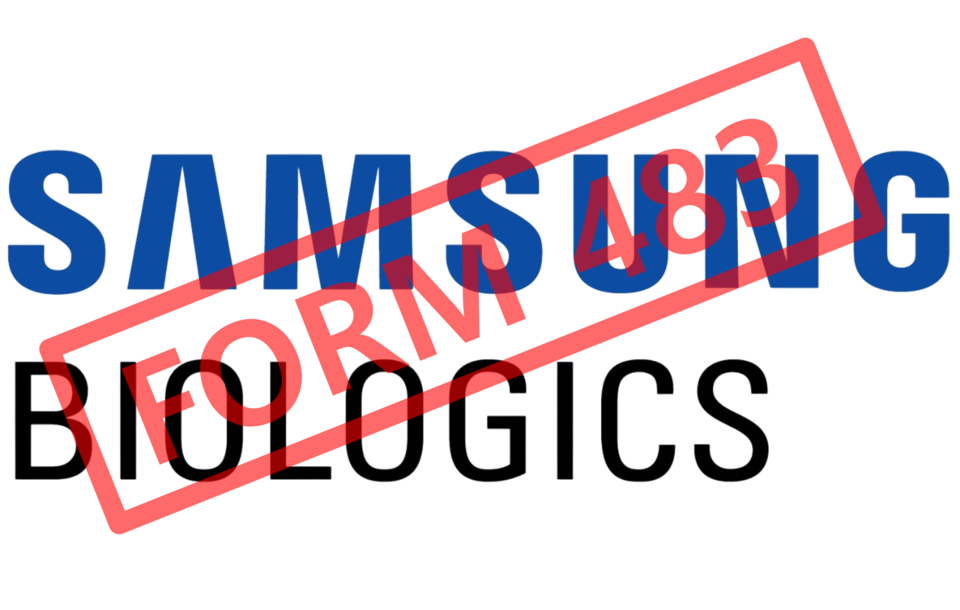Insight into the FDA’s FORM 483 Process and implications for Samsung Biologics
HIT CHECK
Samsung Biologics, a renowned contract manufacturing organization (CMO) for biopharmaceuticals, is facing a red flag after receiving a 'FORM 483' from the U.S. Food and Drug Administration (FDA). This document has put their CMO business under scrutiny, impacting their reputation as a global industry cornerstone. In this article, we delve into the criticisms outlined in the FORM 483 and evaluate their potential repercussions on the biotech industry.
① Three Mistakes of Samsung Biologics as Seen in the FORM 483 Document
② Inadequate Data Integrity Management in the Previously Unaddressed MSAT Department
③ FORM 483 Disclosure and Warning Letters

The recent public disclosure of a 'FORM 483' by the U.S. Food and Drug Administration (FDA) regarding Samsung Biologics has triggered widespread interest in whether this development will culminate in the issuance of a 'Warning Letter.' Historically, when the FDA makes a FORM 483 disclosure, it has resulted in a Warning Letter approximately 8% of the time.
As of October 29th, the FDA has documented 191 instances of FORM 483 disclosures, with 15 cases (around 8%) leading to the issuance of Warning Letters. Notably, in the case of Celltrion, they received a FORM 483 in June 2017, publicly disclosed by the FDA, and approximately seven months later, in January 2018, they received a Warning Letter.
Sun Pharmaceuticals, an Indian-based global contract manufacturing organization (CMO), had its FORM 483 publicly disclosed in August 2022, followed by the issuance of a Warning Letter four months later. Similarly, Japanese-based CMO company Toyobo and Indian-based CMO company Intas Pharmaceuticals both received Warning Letters after their respective FORM 483 disclosures in 2021 and 2022.
The timeframe from FORM 483 disclosure to Warning Letter issuance has ranged from a minimum of 2.5 months to a maximum of 8 months, with an average duration of approximately 4 months. Samsung Biologics received its FORM 483 on September 1st, and approximately 2 months have elapsed since that time.
An industry insider stated, "When FORM 483 is issued, the company must respond to the FDA within 15 business days," adding, "It is likely that Samsung Biologics has already submitted a response containing Corrective Actions and Preventive Actions (CAPA)."
The same source explained, "The timeframe for each case until the issuance of the final FDA report, known as the Establishment Inspection Report (EIR), varies," and speculated, "The decision on whether to issue a Warning Letter may be made as early as 2 months or as late as 6 months after the inspection."
On October 17th, the FDA officially disclosed the FORM 483 issued to Samsung Biologics on its website. This FORM 483 lists six items, and some in the industry have interpreted certain aspects, such as inappropriate data integrity management, delay in device revalidation, and inadequate facility management, as potential "violations of basic GMP principles."
Within the industry, there is a difference of opinion regarding the significance of this FORM 483. Some argue that "FORM 483 typically follows inspections," while others believe that "the fact that the FDA chose to disclose Samsung Biologics' FORM 483 suggests a different level of seriousness."
It's important to note that not all FORM 483s are publicly disclosed on the FDA website. The FDA only makes FORM 483 public in cases mandated by the Federal Food, Drug, and Cosmetic Act (FD&C Act) or when there is significant external demand for information disclosure.
The Process from FDA's 'FORM 483' to a 'Warning Letter'
The FDA inspection process begins when the company receives a document known as 'FORM 482,' which notifies them of the inspection schedule and location (Site). 'FORM 483' is a document issued by the FDA to the company at the conclusion of the inspection when observations are made.
FORM 483 is a document that requests corrective actions following the inspection and is issued on the last day of the inspection. It doesn't explicitly identify 'violations' of Good Manufacturing Practices (GMP) but rather lists 'observations,' indicating manufacturing process issues.
The Establishment Inspection Report (EIR) is an inspection report that includes inspection details and the inspection rating (NAI, VAI, OAI) and is typically generated within 30 days after the inspection's completion. If the FDA assigns an OAI (Official Action Indicated) rating in the inspection report, a Warning Letter ensues.
In essence, a Warning Letter is issued to companies that receive FORM 483 during the inspection process and have an inspection rating of 'OAI' (Official Action Indicated). 'NAI' (No Action Indicated) and 'VAI' (Voluntary Action Indicated) are acceptable ratings that do not lead to the issuance of a Warning Letter.
관련기사
- FDA 'FORM 483', 워닝 레터로 이어지는 비율은
- FDA "삼성바이오로직스, DI 관리 부적절"… 문제는 예견돼 있었다
- 품질 완벽주의 삼성바이오로직스는 왜 'FORM 483'을 받았나
- Samsung Biologics’ FORM 483: Unusual 5-Member FDA Inspection
- Samsung Biologics : Quality Unmasked by 'FORM 483'
- FORM-483 Exposes Data Integrity Issues at Samsung Biologics
- Samsung Biologics: FORM 483’s Impact on Customer Product Approvals
- Decoding Samsung Biologics’ FORM 483: Anycall’s Untold Tale

